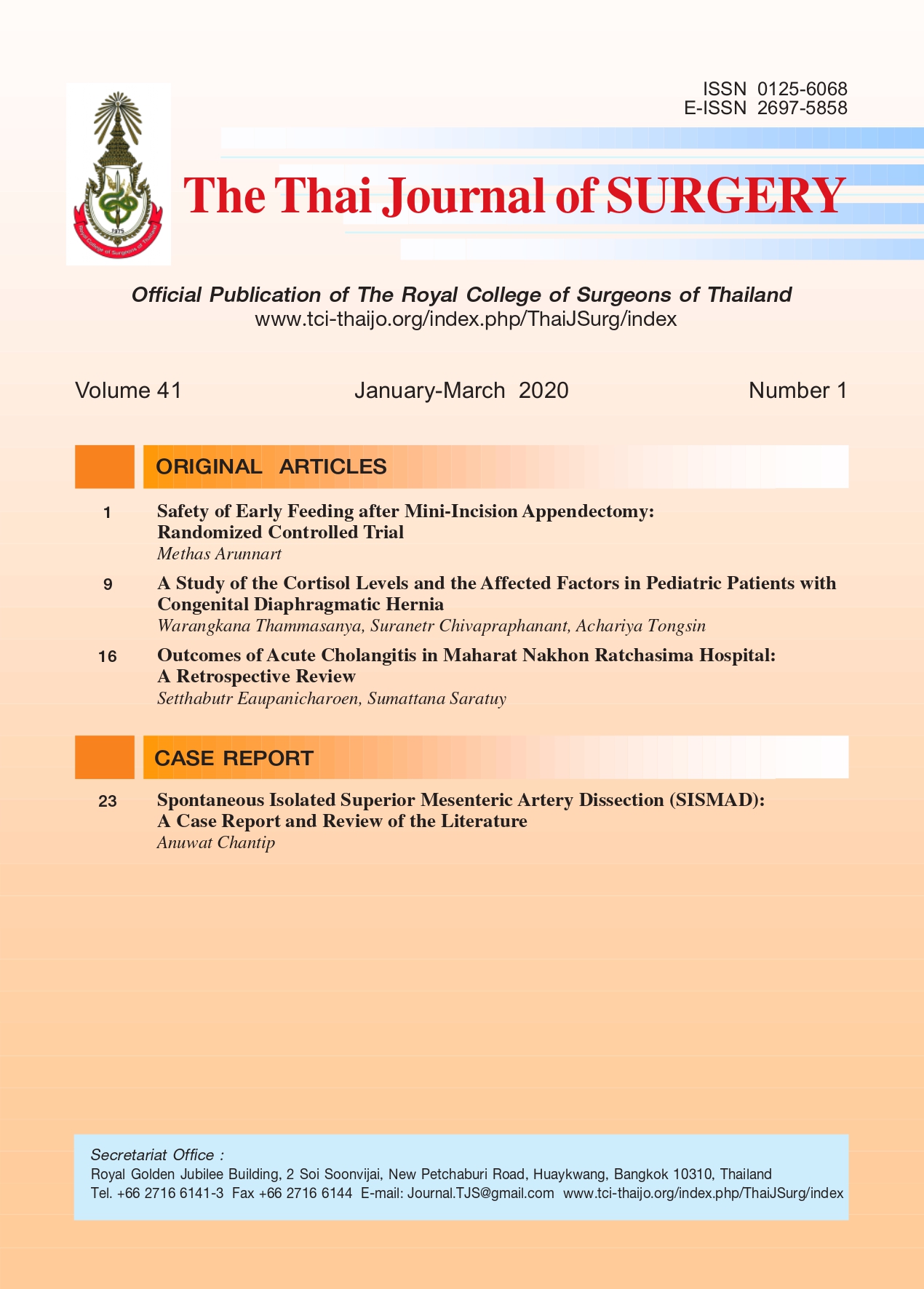A Study of the Cortisol Levels and the Affected Factors in Pediatric Patients with Congenital Diaphragmatic Hernia
Keywords:
Congenital diaphragmatic hernia, Cortisol levels, Mean airway pressure, Oxygenation indexAbstract
Objective: Congenital diaphragmatic hernia (CDH) is one of the most serious diseases in pediatric surgery. The morbidity and mortality associated with CDH are largely due to pulmonary hypoplasia and pulmonary hypertension. Low cortisol levels may be associated with the severity of CDH. The aim of the present study was to study the cortisol levels and evaluate factors associated with cortisol levels in pediatric patients with CDH.
Materials and Methods: A retrospective study was conducted by reviewing the medical records of infants with CDH admitted to the Queen Sirikit National Institute of Child Health (QSNICH) between August 1, 2017 and December 31, 2018. The cortisol levels of these infants were recorded and evaluated to study the factors that may be associated with decreased cortisol levels. A cortisol level that was less than 15 mcg/dl was designated as lower than the normal level. The data was analyzed using the Chi-square, Student t-test, and Pearson correlation methods. A p-value of less than 0.05 was considered significant for the purposes of this study.
Results: Twenty-eight infants with CDH (14 males, 14 females) were treated at QSNICH. The ratio of patients with low cortisol levels (< 15 mcg/dl) to normal cortisol levels (> 15 mcg/dl) was 2:1 (19:9). Within both groups, 68% of the infants developed hypotension and a subsequent 70% of these hypotensive patients required additional use of hydrocortisone and inotropic drugs in order to sustain normal blood pressure. Low gestational age was associated with low cortisol levels in these infants (p = 0.044). High mean airway pressure and high oxygenation index appear to have some correlation with low cortisol levels. Survival rates between CDH patients with low and normal cortisol groups were not significantly different (73.7% vs. 77.8%; p = 0.815), and the overall survival rate of all patients was 75%.
Conclusion: Of the 28 infants with CDH, approximately two-thirds had a low cortisol level. There was an association between low cortisol levels in infants with CDH and higher mean airway pressure and oxygenation index. Hydrocortisone may be used in CDH patients with low cortisol levels and inotrope-resistant hypotension in order to sustain a normal blood pressure.
References
Chankaew O, Niramis R, Burankitjaroen V. Postnatal factors for survival of neonates with congenital diaphragmatic hernia. J Dept Med Serv 2018;43:131-6 (in Thai).
McGivern MR, Best KE, Rankin J, et al. Epidemiology of congenital diaphragmatic hernia in Europe: a register-based study. Arch Dis Child Fetal Neonatal ED 2015;100: F137-F144.
Wilson JM, Lund DP, Lillehei CW, et al. Congenital diaphragmatic hernia – a tale of two cities: the Boston experience. J Pediatr Surg 1997;32:401-5.
Cartidge PHT, Mann NP, Kapila L, et al. Preoperative stabilization in congenital diaphragmatic hernia. Arch Dis Child 1986;61:1226-8.
Shanbhogue LKR, Tan PKH, Ninan G, et al. Preoperative stabilization in congenital diaphragmatic hernia. Arch Dis Child 1990;65:1043-4.
Wung JT, Sahni R, Moffitt ST, et al. Congenital diaphragmatic hernia: survival treated with very delayed surgery, spontaneous respiration and no chest drain. J Pediatr Surg 1995;30:406-9.
Kamath BD, Fashaw L, Kinsella JP. Adrenal insufficiency in newborns with congenital diaphragmatic hernia. J Pediatr 2010;156:495-7.
Pizarro CF, Troster EJ, Damiani D, et al. Absolute and relative adrenal insufficiency in children with septic shock. Pediatr Crit Care Med 2005;33:855-9.
Thai Resuscitationn Council. Handbook of pediatric advanced life support for medical personels. 1st ed. Bangkok : How Can We Do Co. Ltd; 2009: 8 (in Thai).
Rienmanee N, Wacharasindhu S. Basal serum cortisol as a predictor for adrenal reserse in children with adrenal insufficiency. Asian Biomed 2009;3:135-41.
Fernandez E, Schrader R, Watterberg K. Prevalence of low cortisol values in term and near-term infants with vasopressor resistant hypotension. J Perinatal 2005;25:114-8.
Cooper MS, Stewart PM. Adrenal insufficiency in acutely ill patients. N Engl J Med 2003;348:727-34.
Singhi SC. Adrenal insufficiency in critical ill children: many unanswered questions. Pediatr Crit Care Med 2002;3:200-1.
Menon K, Clarson C. Adrenal function in pediatric critical illness. Pediatr Crit Care Med 2002;3: 112-6.
Widmer IE, Puder JJ, Konig C, et al. Cortisol response in relation to the severity of stress and illness. J Clin Endocrin Metab 2005;90:4579-86.
Robertson JO, Criss CN, Hsieh M, et al. Steroid use for refractory hypotension in congenital diaphragmatic hernia. Pediatr Surg Int 2017;33:981-7.
Downloads
Published
How to Cite
Issue
Section
License
Articles must be contributed solely to The Thai Journal of Surgery and when published become the property of the Royal College of Surgeons of Thailand. The Royal College of Surgeons of Thailand reserves copyright on all published materials and such materials may not be reproduced in any form without the written permission.



